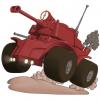If there is one thing I hate about platformers in general, and especially the 8 / 16 bit era 2D and PS1 / N64 era 3D ones, its inprecise controls / jump timing...
There is nothing worse than having to die multiple times just to get the exact jump timing into muscle memory every time you pick up a platformer you haven't played for a while. Many of the 2D classics had this "problem", which was pretty much accepted back in the days. It is nothing that cannot be overcome with practice, but throw in some mechanics that rely on precise jump timing, and every time one of these mechanics got introduced in later levels, the whole die-multiple-times-to-get-timing-into-muscle-memory routine started all over again.
A good example is Super Castlevania... a very good title else (especially the soundtrack... it was kicking ass for its time! And one of the few 16bit era soundtracks that aged well even to this day)...
But the controls were... lacking, to put it in a nice way. Lets list what was wrong:
1) inprecise collision geometry vs. need for exact timing: many times you were required to max out your jump reach, but the visual edge of the platform wasn't guaranteed to be the collision edge... could have been the other way around as the collision geometry of belmont most probably was just a quite large square. So you had to try a few times how far you could move before you would fall, and how far you needed to move to still be able to succeed the jump. The next point also didn't help with this
2) lacking animations: Belmont only got very few animations. That was hardly suprising for an early SNES title that most probably had to fit unto a 8MB Cartridge, still, when you moved to the edge of a platform, no animation would tell you that you did. Which in turn made it hard to know exactly how far you could move belmont (his feet would just start to be placed in thin air). Jumping was a 1-2 animation frame affair... which made "double jumping" harder to pull off when you had to jump unto a crumbling platform and get away in under a second
3) laggy controls: its always hard to say what causes it, but I couldn't shake the feeling that controls were slightly lagging in Super Castlevania... there just was not that direct feeling you get in a good super mario game to jumping or attacks.
4) The final nail in the coffin: building additional difficulty on that shaky foundation! Really, some levels drove me mad, I had to consult online help pages just to verify I didn't miss something.
In the Clocktower, where you, for the first time, face the turning platforms, and need to double jump unto and away from these things. Before you could always just jump over them. Now you needed to land on them, and as they turn in half a second, catapulting belmont into the abyss below them, you literally have to react in a split second. I tried and failed.... just to find out online "yes, you just need to jump faster"... you need to push the jump buttons basically instantly when belmont touches down on the platform, because else he goes into a kind of kneeling stance and has to recover for half a second to make another jump... just long enough that he will be thrown into the pit and you need to restart from the last checkpoint.
I don't know anymore how I managed to clear the Clocktower during my first playthrough in the nineties, as the internet was not there yet and I never had money for the guides.... I guess lots and lots of time an patience, and little else to do as a teen :)
There were other things like that, crumbling platforms for example... if you need to leave a platform in split seconds, but need to fight with the controls to make precise jumps, it will often end in misjumps...
The fact that I still played through the game even though the controls drove me nuts at times just speaks for the quality of the rest of the game....
When it comes to 3D platformers, its not only the imprecise control, but also the need for 3D steering in the early titles... trying to reach high up platforms without falling to your death in the first Tomb Raider was such a pain in the ass, that it really stopped me from enjoying the game.... so much potential ruined by badly designed platforming elements. I wished they just gone for an action-adeventure / shooter without platforming elements....
I remember the first 3D Mario also being a pain in the butt to navigate.









